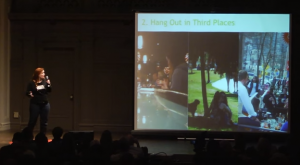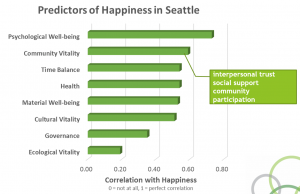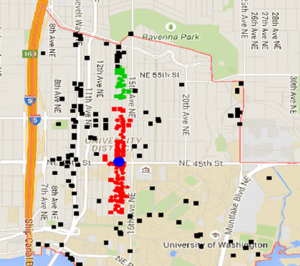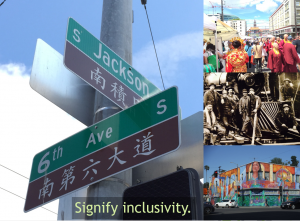Our Executive Director Shelly Farnham gave an Ignite talk last week to a sold out house of over 800 people at Town Hall last week. Below is the video, and a slightly extended version of the talk in text.
The Data Is In: How to Improve Your Neighborhood Community’s Wellbeing
Greetings everyone! I’m a social psychologist by training, a research scientist specializing in community technology research and development. At Third Place Technologies, in the past couple years, we have been exploring how to leverage new technologies to really quantify and improve neighborhood community wellbeing.
Predictors of Happiness in Seattle
I’m a big believer in the power of a thriving community to positively affect our quality of life. Past research has shown that participating in a vital community, characterized by interpersonal trust, social support, and citizen engagement, is one of the strongest predictors of a person’s happiness.
More Urban = Less Connected
Ironically, in larger cities such as Seattle, research also shows that the more urban the environment, the less connected we are. Even though there are more people per square foot, we have fewer friends within walking distance than those in more suburban or rural neighborhoods. This is especially true in Seattle – you have all heard of the Seattle “freeze” – it can be really hard to connect here.
Take the Zombie Apocalypse Test
Communities are not only important for happiness, they can make the difference between life and death in crisis situations. I want you to ask yourself this – I like to call this the Zombie Apocalypse Test – if there were, say, a Zombie Apocalypse, do you know and trust enough people within walking distance that you could successfully band together to not only fight off the Zombie Horde, but also to recreate society as we know it?
Chances are – probably not.
What Can You Do?
So, what can you do? As a citizen, a community organizer, or a local business, what can you do to improve the wellbeing of your neighborhood community? As we are building toward our future here in the Pacific Northwest, what can we be doing to assure we are all members of happy, thriving communities of mutual trust and social support, with the strength to withstand any crisis situation?
Third Place Technologies / Spokin.org
Helping you answer this question is a primary goal for us at Third Place Technologies, where our mission is to foster community wellbeing through innovation in technology. Our main project is Spokin.org, an online civic network designed to help you connect with your local communities, but also, more importantly, to help you better understand what factors impact your neighborhood’s wellbeing and start a dialogue around what you should seek to change.
We are doing this through interactive neighborhood report cards.
The Research
In order to scientifically quantify a neighborhoods wellbeing, we have been performing a lot of research, and analyzing a lot of data. Lots, and Lots of data, including self-report interviews and questionnaires, social media such as Twitter and Facebook, and open data, such as from the U.S. census or crime reports. We are weeks away from making Spokin public, at which time I strongly encourage you to check out your neighborhood’s report card, which looks something like this.
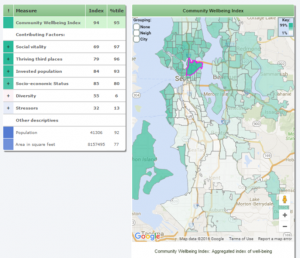
Community Wellbeing Report Pages — Metrics on the Left, Map Showing How Your Neighborhood Compares on the Right
Neighborhood Community Well-being Report Pages
Factors that meaningfully impact wellbeing are on the left, and a map visualizing how your neighborhood compares to other neighborhoods is on the right. Today, for the rest of this talk, I want to share with you our top recommendations for what you can do improve your neighborhood’s wellbeing based on what we’ve learned from our research.
Recommendation #1. Join the Conversation!
First, a necessary condition of a thriving community is that people know each other and regularly interact. In most neighborhoods there is already a conversation happening about local issues – in coffee shops, town meetings, or online – and our top recommendation is simply that you find and join this conversation. It is not enough that you observe this conversation, it’s important that you have a voice and express your opinions.
Face-to-face is Best, but Online Works Too
Face to face interactions are always more impactful, however online interactions are effective as well. Our research shows that social media can be an effective tool to help compensate for a lack of face-to-face interactions – such as found in more urban environment – but again, only if you are expressing yourself and actively conversing with others.
Recommendation #2. Hang Out in Third Places
This raises the question, where are you going to find these conversations. It turns that Third Places are another important feature of thriving communities. A Third Place is a place outside the home, or outside of work, such as a coffee shop, restaurant, or park, where people can meet serendipitously, and through frequent exposure to each other be transformed from strangers to friends.
Third Places are breeding grounds of community.
Your job is figure out where the locals hang out in your neighborhood, and then go hang out there.
CREATE Third Places
A successful neighborhood will have a lot of these Third Places, and we have found, the more they are all clustered together, such as seen here in the University District, the better it is for the neighborhood, because that area itself becomes a Third Place, increasing all that fabulous serendipity on the streets. If you do not have this pattern of third places in your neighborhood – you need to create one. Start a local business, a park, or something more temporary, like a street fair or block party.
Recommendation #3. Invest in Your Hyper-local Economy
Not too surprisingly, the economic success of your neighborhood strongly impacts the community. Our third recommendation is that you invest in the micro economy of your neighborhood. Spend locally, work locally, hire locally. On a related note, the average education of your residents also meaningfully impacts community wellbeing, so keep your kids in school, and support youth education initiatives.
Extreme Wealth is not Good for your Hood
Interestingly, economic success is not always a good thing. We found in our research that some of the more extremely wealthy neighborhoods – represented by the darker maroon on the left – are not as high in community wellbeing – represented by the teal on the right – we believe because these neighborhoods don’t tend to have third places, and wealthy families are more isolated and disengaged. If you are lucky enough to experience a sudden change in fortune, don’t leave for the bigger house out in Medina. It’s lonely out there.
Recommendation #4. Find your Community Hubs
Most successful neighborhoods have what we call a community hub. This is a person that everyone trusts, they might have all of your phone numbers, or copies of your keys for when you are out of town. They probably maintain a mailing list, facebook group, or blog, and perhaps most importantly are the keepers of all the local gossip.
Get to know this person, because he or she is doing a lot of the “work” of forging community connections for you.
Be the Community Hub
If there is no such hub in your neighborhood – become the community hub. Justin, or @JSeattle in Capitol Hill is a really good role model for this. He has a great blog, is very present at local events and venues, and really effectively uses Twitter to not only broadcast information, but to really engage in conversation around neighborhood issues. When we performed a Twitter network analysis, we found he was the center of a highly interactive Twitter network of Capitol Hill denizens.
Recommendation #5. Celebrate Diversity
Diversity – in age, race, sexual orientation – is a double edged sword. On the one hand, diversity can greatly improve a group’s creativity and problem-solving through different perspectives and skills. On the other hand, it can be a source of great tension and distrust. What makes the difference, is how inclusive a community is. That is, to what extent does everyone feel like their voice matters? In your neighborhood are people balkanized – hunkering down into separate groups and not talking to each other?
Or, is there a feeling of inclusiveness?
Signify Inclusivity
It’s important to think about how do you celebrate diversity and signify inclusivity in your neighborhood. Festivals or parades are very effective, such as the International District’s Dragonfest, or Gay Pride. Role models are extremely important — in your community’s storytelling, how much do you incorporate people of different backgrounds in your historical accounts? What role models are celebrated in your local news media, or public art?
Take Pride
I personally love murals as cultural signifiers — large scale murals embedded in neighborhoods, can have a powerful impact people’s sense of community — increasing that feeling of belonging and voice for some, and for others helping them take pride in their community’s diversity. I cannot emphasize enough how important this is – in our research we found that distrust and balkanization across racial lines in particular had the most negative impact on a neighborhood community’s wellbeing.
In Sum, Overcome Your Fear of Strangers
In sum, I want to emphasize that your fear of strangers is the biggest threat to your neighborhood community’s wellbeing. It is as if you already believe you are under attack from a zombie horde out to eat your brains. I promise you, however, that most people, like you, are human – they care, they mean well, they are not criminals. The trick, is to connect around what you have in common — and at the least, you can always connect around the fact that you live or work in the same neighborhood.
If you want a sneak preview of Spokin.org, email shelly at thirdplacetechnologies.com

